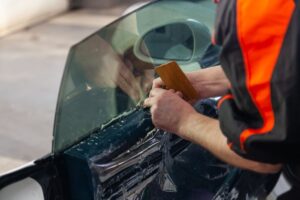Window tint laws did take the car owners’ world by storm when authorities started setting legal certified rules for car tinting darkness.
If you are one of those people, this article will find you with good knowledge.
The tinting law was first introduced in Virginia in 1999, and if you’re a car owner in this state, then you must know the below rules.
The Virginia window tint laws clearly explains that the VLT of any vehicle should be 50 for the front side windows of the vehicle, whereas the back and rest of the windows must let 35% of light in.
Tinting a vehicle is usually for personal reasons, but these laws were set in place for the safety of the citizens.
Below I will further explain the rules you need to be aware of regarding tinting, its darkness, color, and much more, so keep on reading.
Table of Contents
- 1 How Much Tint Darkness Is Legal In Virginia?
- 2 Window Tint Reflection And Tint Colors
- 3 Medical Exemption Of Window Tint Law In Virginia
- 4 Get A Certified Sticker From The Company
- 5 Other Window Tint Laws Rules And Regulation In Virginia
- 6 Cost Of Car Window Tints In Virginia
- 7 Frequently Asked Questions
- 8 Conclusion
How Much Tint Darkness Is Legal In Virginia?

The legality of the tint darkness varies from state to state. The rules set by one state will be different from the other state.
The tint darkness legality in Virginia is 50% VLT to pass through the front side windows of the vehicle and 35% VLT on all the other windows of the car.
And the AS-1 line of the front shield is allowed to be tinted.
Tint Darkness Level For SUVs And Vans
Now, let’s discuss the types of vehicles and what rules and regulations are set for a set of different vehicles.
For SUVs and vans, Virginia laws state that the front windshield is allowed to tint, but only the first 5 inches and the tint should be reflective.
The front side windows must allow 50% light under any circumstance, which means the front side windows are allowed to have 50 VLT.
The rear windows can have any level of tint darkness for these family-size vehicles, and just like the rear windows, the back seat side windows are also allowed to have whatever tint darkness the owner of the vehicle prefers.
Tint Darkness Level For Sedans
Next up, let us talk about sedans and what legality is allowed for tinting darkness in Virginia.
Sedans in Virginia have a bit more strict regulations for tinting on all windows of the vehicle, such as:
1. Front Windshield
The AS-1 line or the first top 5 inches of the vehicle’s front windshield can be tinted, but only on one condition. The tinting film should be reflective, meaning non-reflective.
2. Front Seat Side Windows
The front-seat side windows, just like the SUVs and Vans, must allow 50% light in at all times, especially while driving.
3. Rear Window
The rear windows of a sedan in Virginia should have 35% light in. Hence the VLT for the rear windows in Virginia, you can simply say, is 35 VLT.
4. Back Seat Side Windows
Back seat side windows and rear windows have the same rule for a sedan in Virginia. The back seat side windows should also allow 35 VLT at all times.
Window Tint Reflection And Tint Colors
- Window tint reflection for sedans in Virginia should not be more than 20% for the front seat side windows and back seat side windows.
- For SUVs and vans, the tint reflection should also be 20% or less, a higher reflection rate will be considered illegal, and you will have to pay up for such illegality.
- In terms of tinted color, red, amber, and yellow are not allowed. Colors other than these 3 are legal and allowed in Virginia.
Medical Exemption Of Window Tint Law In Virginia

You can apply for medical authorization if you have a medical condition that is serious enough for you to surpass the legal rules set by Virginia in terms of window tinting.
If you have to have a higher darkness tinted film, you need proof for such allowance.
The person with a serious medical condition should submit a completed Sun-Shading Medical Authorization Application to the Virginian authorities via the post office box.
This legal permit from Virginia’s legal authority will allow you to have 70 VLT on the entire front shield windows, the front seat side windows can also have 35 VLT, and the AS-1 line of the front shield can have 35% VLT as well.
You will need to get an authorized medical report issued by the physician, nurse practitioner, ophthalmologist, or your local doctor based in Virginia to gain legal permission.
And this report will be presented to the authorities for certified allowance of dark tinted windows in Virginia.
Get A Certified Sticker From The Company
The Virginian authorities have kept it very lenient regarding the certified sticker.
You won’t need to place a sticker on every window of your sedan or SUV to prove the film placed is according to the legal guidelines set by Virginia in terms of tint darkness.
The company you get your tint installed on your windows will provide you with a licensed sticker proving that the vehicle’s tinting is done accordingly.
Hence, if you get pulled over, you can easily show them proof.
And in terms of medical exemption, you must have proof of why your windows are tinted darker than allowed, so you don’t get fined for illegal actions against the rules set by Virginia.
Other Window Tint Laws Rules And Regulation In Virginia
While I already discussed the majority of the rules and regulations, here are a few basic ones you need to keep in mind.
- 7 percent of tint variance is allowed for every window, whether a sedan, SUV, or van.
- If you tint your car, you must have dual mirrors installed in your vehicle.
- The laws set by Virginia in terms of tint darkness are allowed to be altered to some extent in case of a medical condition.
- The film you used does not need to be certified with a sticker. There is no need for it in the laws of Virginia.
When you completely understand and follow these rules and regulations, you won’t have to worry about getting fined in terms of tint darkness in Virginia.
Cost Of Car Window Tints In Virginia
The cost of the car window tints in Virginia depends on the model of your vehicle, its type, size, type of tint you use, the color you pick, the amount of tint you use, and how many windows you tint.
Along with the quality of the tint, there are categories in the tinting film industry. Hence you can either opt for an expensive tint or a more affordable one.
Window tinting in Virginia can cost around $150 to $500 if we roughly estimate the average cost. The rest is totally up to the owner and the facts I mentioned above.
Frequently Asked Questions
Q1. Is 15% Tint legal In Virginia?
No, 15% tint is not legal in Virginia. You might get away with using a darker film such as 15 VLT on the back and rear window of an SUV or van.
Q2. Are 5% Tints Legal In Virginia?
Not, 5% tints are way too dark; hence it is not legal in Virginia to use an almost blind tinting film.
Q3. Is Limo Tint Legal In Virginia?
No, limo tint is also not legal in Virginia, but just like any other dark tinting film, you can use the limo tint on the back and rear window of your SUV or van.
Q4. Can I Get Pulled Over For Tint In Virginia?
Yes, you can get pulled over for tint in Virginia because the police officers have the authority to stop you if they suspect your vehicle’s tinting situation.
Q5. How Much Is A Tint Ticket In Virginia?
The cost of a tint ticket in Virginia is $110, and you might be asked to remove the tinted film as it does not meet the legal rules set by Virginian authorities.
Conclusion
After reading this article, I will guarantee that you would have complete knowledge of the laws set by Virginia in terms of tint darkness.
Remember that these rules and regulations are always changing; hence you should keep yourself updated with the most recent facts.
Virginia tint laws are set specifically for the safety purposes of the citizens. I have discussed all the possible reasons you might get exempted from the legal laws set.

I am Tahir Azam, and I have been writing amazing articles for TaxiHack for as long as I can remember. I know everything that is to know when it comes to automobiles and is always on top of industry news and developments. While I am not an expert by any means, I pride myself on knowing the ins and outs of many different problems and, of course, their solutions. The articles on our website are some of the best and well-researched content that you will find, and I spend countless hours making sure this remains to be true. This is why I ask you to take your time out and read some of my articles, especially if you find a topic that resonates with you or is something you are looking into. This way, you will find the perfect mix of information and tips on your desired topic. Learn more about Tahir.



